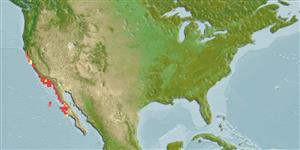>
Ovalentaria/misc (Various families in series Ovalentaria) >
Embiotocidae (Surfperches)
Etymology: Embiotoca: Greek, embios = permanent, for all the life + Greek, tokos,-oy = birth (Ref. 45335); jacksoni: jacksoni for A.C. Jackson , who first noted that black perch bore living young and brought this information to the attention of Alexander Agassiz (Ref. 4930).
More on author: Agassiz.
Environment: milieu / climate zone / depth range / distribution range
Ecologia
marinhas demersal; intervalo de profundidade 0 - 46 m (Ref. 2850), usually ? - 6 m (Ref. 2850). Subtropical; 40°N - 23°N, 124°W - 114°W
Eastern Pacific: Fort Bragg in northern California, USA to central Baja California in Mexico, including Guadalupe Island (off northern central Baja California).
Tamanho / Peso / Idade
Maturity: Lm ? range ? - ? cm
Max length : 39.0 cm TL macho/indeterminado; (Ref. 2850); peso máx. publicado: 700.00 g (Ref. 2850); idade máx. registrada: 10 anos (Ref. 56049)
Adults chiefly live in rocky areas near kelp, occasionally over sand bottom of coastal bays and around piers and pilings, and rarely in surf. Occur from intertidal areas to 46 m depth, but usually at about 6.1 m. Usually form small groups. Viviparous, female carries the developing young (Ref. 205).
Ciclo de vida ou comportamento de acasalamento
Maturities | Reprodução | Spawnings | Egg(s) | Fecundities | Larvas
Viviparous, female carries the developing young (Ref. 205).
Eschmeyer, W.N., E.S. Herald and H. Hammann, 1983. A field guide to Pacific coast fishes of North America. Boston (MA, USA): Houghton Mifflin Company. xii+336 p. (Ref. 2850)
Status na Lista Vermelha da UICN (Ref. 130435)
Ameaça para os humanos
Harmless
Uso pelos humanos
Pescarias: espécies comerciais
Ferramentas
Relatórios especiais
Baixar XML
Fontes da internet
Estimates based on models
Preferred temperature (Ref.
123201): 12.8 - 19.3, mean 16.7 °C (based on 64 cells).
Índice de diversidade filogenética (Ref.
82804): PD
50 = 0.7500 [Uniqueness, from 0.5 = low to 2.0 = high].
Bayesian length-weight: a=0.02951 (0.01493 - 0.05834), b=2.99 (2.81 - 3.17), in cm total length, based on LWR estimates for this species & (Sub)family-body (Ref.
93245).
Nível Trófico (Ref.
69278): 3.3 ±0.38 se; based on food items.
Resiliência (Ref.
120179): médio(a), tempo mínimo de duplicação da população 1,4 - 4,4 anos (tm=1.5; tmax=10).
Fishing Vulnerability (Ref.
59153): Low to moderate vulnerability (29 of 100).
Nutrients (Ref.
124155): Calcium = 95.6 [52.9, 168.8] mg/100g; Iron = 1.15 [0.65, 1.96] mg/100g; Protein = 18.7 [17.7, 19.7] %; Omega3 = 0.264 [0.164, 0.428] g/100g; Selenium = 25.8 [13.2, 51.1] μg/100g; VitaminA = 6.99 [2.16, 22.97] μg/100g; Zinc = 0.694 [0.489, 1.013] mg/100g (wet weight);
